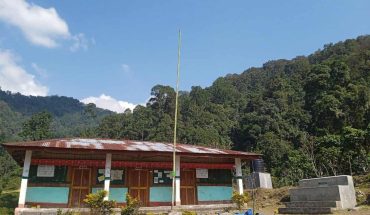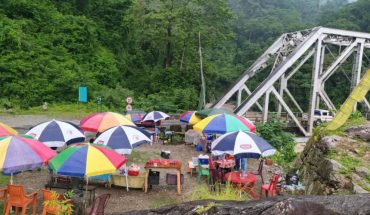
A community of farmers in Dorokha, Samtse works against odds to save a local forest ecology
TENZIN LHAKI
Samtse
As the first rays of the sun light up the southern hills of Bhutan, a soft mist wraps itself around the treetops of Nub Dalemkha. The forest slowly awakens with the sounds of birds chirping and leaves rustling in the breeze. High up in the trees, a red panda moves silently between mossy branches.
For centuries, this peaceful and lush forest—spanning more than 8,200 hectares—has remained untouched by modern development. It is a hidden sanctuary, home to rare and endangered wildlife, and a source of life for nearby communities.
Welcome to Nub Dalemkha, located in Dorokha Drungkhag, Samtse Dzongkhag, this haven for trees and wildlife has been recognized as a High Conservation Value (HCV 2) landscape.
Wild animals like the clouded leopard, Himalayan black bear, and red panda all live in this forest. It also helps regulate the climate and supports people living in surrounding villages.
However, llegal logging, poaching, and the growing impact of climate change are threatening places like Nub Dalemkha. These dangers are challenging Bhutan’s reputation as a green and environmentally friendly nation.
“There’s a deep sadness when you hear a chainsaw in a place like this,” says Sonam Dema, a local forest ranger. “It means someone has crossed a line—not just legally, but spiritually.”
Sonam works with the Department of Forests and Park Services. She patrols Nub Dalemkha several times a week, sometimes with help from local villagers. Together, they look for signs of timber theft or traps set to catch wild animals.
They use both traditional methods—like walking through the forest trails—and modern tools like smartphones to track illegal activities. But despite their dedication, they face many difficulties.
“The forest is huge, and we have only a small team. We are outnumbered and some areas are difficult to reach,” Sonam said.
The demand for timber, especially in neighboring areas and across the Indian border, is also increasing. Nub Dalemkha’s thick trees and isolated location make it an easy target for illegal loggers. These loggers often clear land by hand or even set fires to make room for cutting timber. The damage they leave behind can take decades to recover.
But illegal logging is not the only problem. Another, slower threat is changing the forest in ways that are harder to see: climate change.
Tshering Lhamo, a local who lives near Nub Dalemkha said streams that used to run all year are now dry by late winter. She added that their crops are affected, and sometimes wild animals come to their farms looking for water or food.
Changing weather patterns—such as less rainfall, warmer temperatures, and unpredictable seasons—are affecting the forest ecosystem. Animals are losing their habitats, plants are struggling to survive, and the forest is becoming less resilient.
For the communities living around Nub Dalemkha, the forest is more than just a place for animals. It is a source of firewood, medicinal herbs, clean water, and even spiritual comfort. Many believe the forest has a soul, and that it protects them just as they protect it. When the forest is in danger, their way of life is also at risk.
In recent years, however, there has been a strong movement among the local people to protect Nub Dalemkha. Led by village elders and supported by environmental groups like WWF Bhutan, community members have begun restoring the forest and reviving traditional practices of caring for the land.
“There’s a belief here that the forest watches over us, so we must protect it in return,” says Phuntsho, a village elder. “Our grandparents taught us this, and now we are teaching our children.”
Community groups now work with forest rangers to replant native trees, clean up damaged areas, and track wildlife. They also educate younger generations about the importance of conservation.
These efforts are supported by the International Climate Initiative (IKI), a global program that funds climate and biodiversity projects in countries like Bhutan. Through its partnership with WWF Bhutan, IKI helps provide training, equipment, and research to protect forests like Nub Dalemkha.
One of the most promising ideas being explored is eco-tourism. Instead of cutting down the forest for income, villagers are developing ways to welcome tourists who want to experience its beauty.
Visitors to the area can go on guided nature walks, stay in local homes, and learn about the forest’s plants and animals. This type of tourism brings in money while encouraging conservation.
“Eco-tourism is not about making quick profits,” says Kinley Tshering, a local. “It’s about giving communities a reason to keep the forest standing.”
Still, eco-tourism must be planned carefully. Too many visitors or poor management could damage the forest rather than help it. Villagers want to make sure that they stay in control of how tourism grows, and that their culture and values are respected.
Bhutan’s efforts in Nub Dalemkha are part of a bigger picture. Around the world, forests are disappearing due to deforestation, mining, and climate change. Nub Dalemkha shows that protecting nature is not just the job of governments or scientists—it’s something that must include communities, local traditions, and global support.
Bhutan’s unique approach—combining strict environmental laws, spiritual values, and community action—is a model for others. But even here, the future of forests like Nub Dalemkha is not guaranteed.
Continued international funding, stronger enforcement, and deeper involvement from young people will be necessary to keep the forest safe.
“There’s still hope,” says Sonam Dema, looking out across the green hills. “As long as people care, and as long as we work together, we can protect this forest for our children—and for the world.”
(This story is supported by WWF Bhutan through the JAB’s journalism reporting grant on IKI Living Landscape Project in South Western Bhutan].





